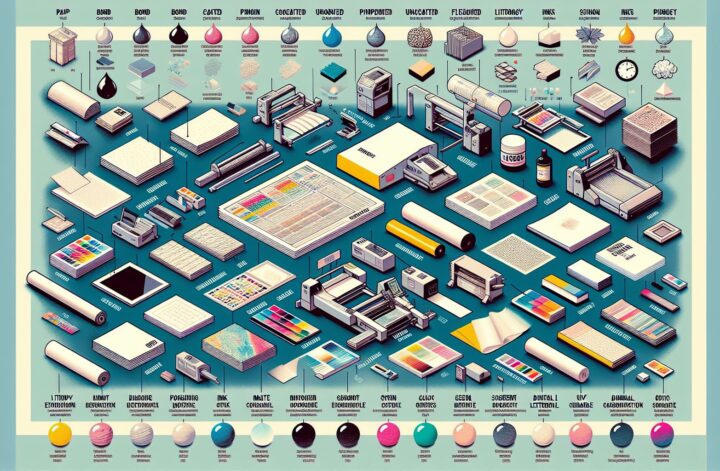Introduction
In today’s digital world, the art of printing has become an integral part of our lives. Whether it’s for personal or professional use, we rely on printed materials to communicate, inform, and express ourselves. However, with the availability of numerous printing materials in the market, it can be overwhelming to choose the right one for your specific printing needs.
In this comprehensive guide, we will dive deep into the world of printing materials. We will explore various types of papers, inks, and other considerations that are vital for achieving the desired results. So, let’s embark on this journey and unlock the secrets behind creating remarkable printouts!
Body
Types of Printing Materials
-
Paper: Paper is the primary medium on which we print our documents, images, and designs. There are several types of paper available, each with its own unique characteristics. The most common types include:
a. Bond Paper: Also known as “copier paper,” bond paper is lightweight and commonly used for everyday printing needs. It is ideal for black and white documents, such as letters, memos, and invoices.
b. Inkjet Paper: Inkjet paper is specially designed to absorb ink from inkjet printers and produce vibrant colors and sharp images. It comes in various finishes, such as matte, glossy, and satin, allowing you to choose the most suitable one for your specific printing requirements.
c. Photo Paper: As the name suggests, photo paper is used specifically for printing photographs. It is available in different weights, textures, and finishes, such as gloss, luster, and metallic, enabling you to achieve various desired effects.
d. Cardstock: Cardstock is a thicker and sturdier paper, often used for printing business cards, invitations, postcards, and other high-quality printed materials. It provides a more durable and professional appearance.
-
Ink and Toner: The choice of ink or toner greatly influences the quality, longevity, and cost of your printed materials. There are mainly two types of inks used in printers:
a. Dye-based ink: Dye-based ink is commonly used in inkjet printers. It produces vibrant and saturated colors, making it an excellent choice for printing photographs and graphics. However, it tends to fade over time and may not be suitable for long-term archival purposes.
b. Pigment ink: Pigment ink consists of tiny particles that sit on top of the paper, resulting in more water and fade-resistant prints. It is often used in professional-grade printers and is ideal for documents and images that require long-lasting quality.
When it comes to laser printers, toner is used instead of ink. Toner is a powdered substance that is fused onto the paper using heat. It provides fast and smudge-resistant prints, making it suitable for high-volume printing and business-related materials.
Considerations for Choosing Printing Materials
-
Intended Use: The type of printing materials you choose depends on the purpose and application of your printouts. For example, if you’re printing a resume or an important business proposal, you may want to use high-quality paper and laser toner for a professional appearance and durability. On the other hand, casual and day-to-day printing needs may not require the same level of sophistication.
-
Color Reproduction: If you frequently print images, graphics, or photographs, you should consider investing in high-quality inkjet paper and dye-based ink. These materials offer better color reproduction and vibrancy. Conversely, if you primarily print text-based documents, such as reports or contracts, using standard bond paper with pigment-based ink or laser toner would be more cost-effective.
-
Environmental Impact: Sustainability is an increasing concern for many individuals and businesses. If you aim to reduce your environmental footprint, consider using recycled paper or environmentally-friendly alternatives. These options often have certifications such as FSC (Forest Stewardship Council) or PCW (Post-Consumer Waste).
-
Printer Compatibility: Ensure that the printing materials you choose are compatible with your printer model. Some printers are designed for specific types of paper or require specific ink formulations for optimal performance. Check your printer’s manual or manufacturer’s recommendations before purchasing printing materials.
Maintenance and Storage
To ensure the best performance and longevity of your printing materials, proper maintenance and storage practices should be followed. Here are some essential tips to keep in mind:
-
Store printing materials in a cool, dry place, away from direct sunlight, extreme temperatures, and humidity. These factors can degrade the quality of the materials and affect the printouts.
-
Keep papers and cardstock in their original packaging or resealable bags to prevent moisture absorption and prevent dust accumulation.
-
Regularly clean your printer to prevent clogging and maintain print quality. Follow the manufacturer’s guidelines for cleaning and maintenance.
-
Use printing materials within their recommended expiration dates, as older materials may not produce the best results.
Conclusion
Printing materials play a crucial role in the outcome of your printouts. By understanding the different types of papers, inks, and other considerations, you can optimize your printing experience and achieve the desired results for various printing needs. Remember to consider factors such as intended use, color reproduction, environmental impact, and printer compatibility when selecting your materials. By following proper maintenance and storage practices, you can ensure the longevity and performance of your printing materials while enjoying high-quality printouts for years to come. Happy printing!

